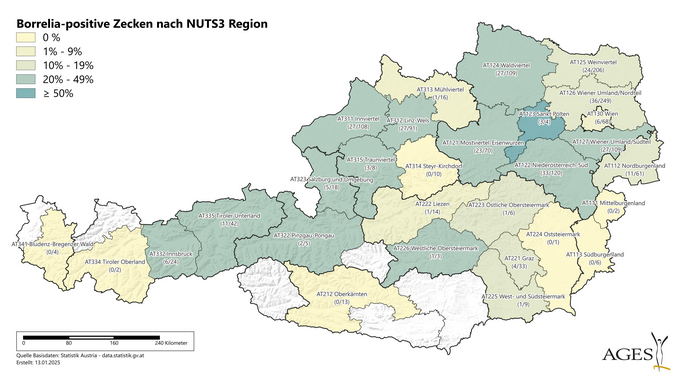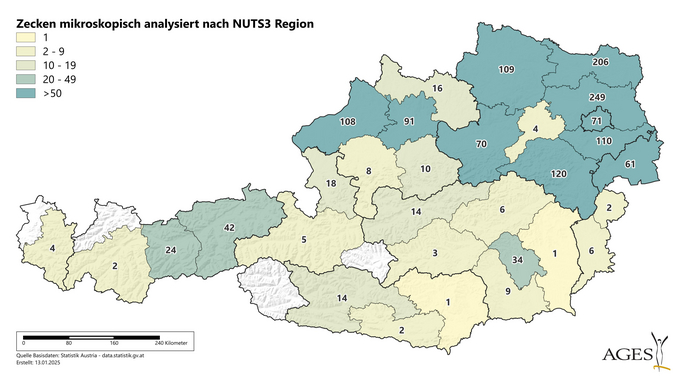Summary
Ticks and mosquitoes can transmit infectious diseases as vectors. In the SURVector project, we are setting up a nationwide mosquito and tick monitoring system. The aim of the project is to establish a one-health surveillance system for emerging pathogens, in which mosquitoes and ticks are collected and analysed for relevant pathogens.
Project description
Zoonoses are infectious diseases that can be transmitted reciprocally between animals and humans. Around 60 per cent of all human infectious diseases worldwide are caused by zoonotic pathogens. The risk of new zoonoses spreading increases with the destruction and modification of natural habitats by humans. These new zoonoses pose a considerable risk to public health as they have epidemic potential and there are hardly any diagnostic and therapeutic countermeasures available.
This project focuses on mosquito-borne West Nile viruses, tick-borne Lyme disease bacteria and Crimean-Congo haemorrhagic fever viruses. The project activities include the Austria-wide collection and sampling of vectors (disease vectors), species identification and pathogen screening, the expansion of capacities in the laboratories and the establishment of a national vector database for the joint utilisation of vector data. The aim is to recognise the entry of new vector species and new pathogens into Austria at an earlier stage and to continuously monitor the geographical spread of vectors and pathogens already present in the country.
Interim results

Ticks
In 2024, we analysed a total of 1,420 ticks under the microscope. The majority of ticks belonged to the genus Ixodes (86.5 %), followed by Dermacentor ticks(11.3 %), Haemaphysalis ticks(1.6 %) and other tick species (0.6 %).
1,411 ticks were analysed for Borrelia. Of these, a total of 19.8 % were positive. The human-relevant Ixodes ticks showed a combined infection rate of 22.5 %.
In 2024, we received 11 reports from the public that we were able to confirm as Hyalomma ticks. The majority of these ticks were imported from Croatia. Eight of these ticks have so far been sent to us for analysis and tested for Crimean-Congo haemorrhagic fever virus (CCHFV) and rickettsiae . CCHFV was not detected in any of them, but three (37.5 %) were positive for Rickettsia aeschlimannii.
Mosquitoes
In 2024, a uniform Austria-wide monitoring programme for the surveillance of West Nile virus (WNV) in mosquitoes was carried out for the first time. To this end, traps were set up at 68 locations twice a month from May to October. The individuals caught were identified by species and analysed for the presence of WNV. A total of 7,927 mosquitoes were caught, most of which were Cx. pipiens/torrentium, the most important vector of WNV in Europe. The mosquitoes were grouped into 1,364 pools and WNV was detected in three pools. The positive samples were taken at the beginning of August in Eisenstadt (Burgenland; two detections) and Lobmingtal (Styria).
The main target species for this monitoring, the common house mosquito Cx. pipiens/torrentium, was by far the most common mosquito species caught, accounting for 75 % of the total. As this species complex is the most important vector for WNV in Europe, high catch numbers of this species are essential for the success of WNV surveillance in mosquitoes.
Aedes vexans, the second most common species, is a typical representative of the flooding mosquitoes. The females lay their eggs in dry floodplains, especially in riparian forests, where they can often survive for several years without water. If the eggs are flooded after a flood event, the larvae hatch en masse. This was also shown in this study, where Ae. vexans was caught in large numbers at the beginning of July and the beginning of October, both after severe flooding events.
Cx. modestus was also still caught relatively frequently, occurring more frequently in late summer in particular. This species is also an important vector species for the WNV. Shallow, sunny waters, often with rich vegetation, are favoured as breeding waters, which may also have a slightly higher salt content. This species was found in large numbers in Illmitz, near Lake Neusiedl, where it finds ideal conditions.
In this first year of standardised WNV surveillance in mosquitoes throughout Austria, a network of trap sites was successfully established in cooperation with the participating provincial health authorities and a number of volunteers. The main vectors were caught in a targeted manner. However, a higher detection rate of WNV in the mosquitoes would require a higher overall number of individuals to be caught. An adjustment of the trapping dates is therefore planned for 2025 so that they are more concentrated in the main activity phase of the mosquitoes. Furthermore, trap locations with particularly low trap numbers are to be relocated where possible.
Annual report 2024 on Austria-wide West Nile virus monitoring in mosquitoes
Saisonaler Verlauf der mittleren Anzahl der gefangenen Stechmücken (nur Weibchen) pro Fangereignis im Jahr 2024
Benefits of the project
The project contributes to protecting the health of humans, animals and the environment by recognising epidemics at an early stage and monitoring outbreaks of zoonotic diseases. In the spirit of a One Health approach, cross-sectoral cooperation at national and cross-border level will be strengthened and a coordination mechanism established to ensure a regular exchange of knowledge, threat reports and a joint risk assessment.
Project details
Project title: One Health Surveillance and Vector Monitoring for cross-border pathogens
Project acronym: SURVector
Project management: AGES, Annette Nigsch
Project partner: National Institute of Public Health (SZU, Czech Republic), University of Veterinary Medicine and Pharmacy Kosice (UVMP, Slovakia), National Public Health and Pharmaceutical Center (NNGYK, Hungary), Hungarian National Food Chain Safety Office (NFCSO, Hungary), Ethnikos Organismos Dimosias Ygeias (EODY, Greece), Aristotele University of Thessaloniki (AUTH, Greece) and Ellinikos Georgikos Organismos - Dimitra (ELGO, Greece)
Funding: EU4Health Work Programme CP-g-22-04.01 (HaDEA)
Project duration: 01.2024 - 12.2026
For questions about the project please contact ohsurvector@ages.at

Downloads
Last updated: 30.09.2025
automatically translated

